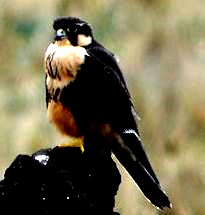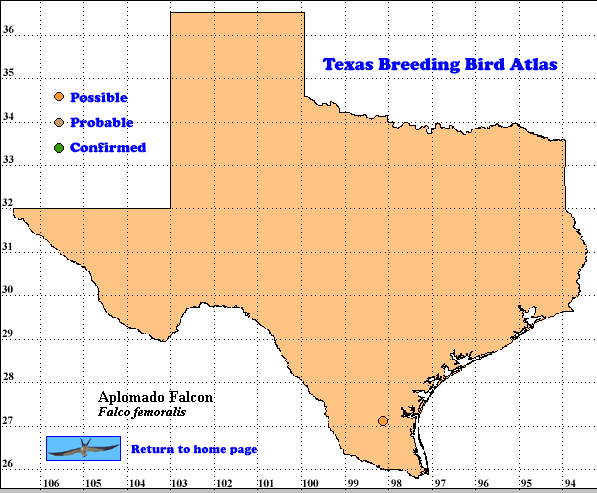The long-legged and long-tailed Aplomado Falcons use their speed and maneuverability in flight and ability to move rapidly on the ground in open habitats to capture their favorite prey, birds (such as pigeons and doves) and larger insects. They supplement these prey with small mammals and reptiles (especially lizards). These falcons are often seen perched in trees or on taller yuccas (Keddy-Hector 2000).
Populations of these falcons in Texas and northern Mexico have been drastically affected by habitat loss and degradation as well as the use of persistent pesticides. Current estimates indicate continued expansion of farming in northern Mexico will eliminate Aplomado Falcons there in the next few years. The northern subspecies (F. f. septentrionalis) has been classified as endangered under federal law (Oberholser 1974, Howell and Webb 1995, Keddy-Hector 2000, McGrath 2008).
DISTRIBUTION. During the 1987-1992 field work seasons of the TBBA project, atlasers found possible breeding evidence for the Aplomado Falcon in latilong-quad 27098-B2. The atlas field work coincided with the start of reintroduction along the Texas coast. As of 2004, almost 700 of these falcons had been released and the possible record probably results from some of these released birds. After the atlas field work was finished, nesting was reported in coastal counties from Cameron to Calhoun. The initial release sites at Laguna Atascosa National Wildlife Refuge are now fully occupied by highly territorial breeding pairs and the release program has been expanded to privately-owned ranches in the yucca-grasslands of west Texas where breeding by released birds has been observed (Lockwood and Freeman 2004, McGrath 2008).
These falcons also breed in coastal areas of east and south Mexico and Central America as well as through much of South America where they are found as high as 4000 m (13,000 ft) in the Andes (Howell and Webb1995, Am. Ornithol. Union 1998, Keddy-Hector 2000).
SEASONAL OCCURRENCE. Aplomado Falcons are permanent residents in Texas and have historically bred from late February to October, based on egg dates from March 3 to September 12 (Oberholser 1974, Lockwood and Freeman 2004).
BREEDING HABITAT. In Texas Aplomado Falcons historically bred from near sea level to about 1400 m (4500 ft) in arid grasslands with scattered mesquite,yucca and cactus (Oberholser 1974). Historically nesting habitats in the grasslands of southeast Arizona were apparently similar with Aplomado Falcons also nesting at the outer edges of riparian woodlands surrounded by grassland. The last reported nest in Arizona was found in 1940 (Corman 2005). Nest platforms of sticks or twigs are often placed in mesquite or tall yuccas, 3-4 m (10-14 ft) above ground. In the grass lining, the female usually lays 2-3 white or buffy eggs, variously marked with reddish browns. Incubation, mostly by the female, usually lasts 31-32 days and the young fledge 4-5 weeks after hatching (Harrison 1979, Keddy-Hector 2000).
STATUS. Aplomado Falcons, extirpated in the southwestern United States and northern Mexico for as long as a century, have been reintroduced in Texas. The captive-reared birds were released in the last 20 yeast and are now considered rare to locally uncommon. Nesting has been reported since completion of the TBBA field work. (Oberholser 1974, Howell and Webb 1995, Keddy-Hector 2000, Lockwood and Freeman 2004). The return of these handsome birds to this state, and thus to the United States is certainly a cause for celebration.
Text by Robert C. Tweit (2008)
Literature cited.
American Ornithologists’ Union. 1998. Checklist of North American birds, 7th ed. Am, Ornithol. Union, Washington, DC.
Corman, T. E. 2005. Aplomado Falcon (Falco femoralis). In Arizona breding bird atlas. pp. 601-602 (T. E. Corman and C. Wise-Gervais, eds.), University of New Mexico Press, Albuquerque.
Harrison, H. H. 1979. A field guide to western birds’ nests. Houghton Mifflin, Boston, MA.
Howell, S. N. G. and S. Webb. 1995. A guide to the birds of Mexico and northern Central America. Oxford University Press, New York.
Keddy-Hector, D. P. 2000. Aplomado Falcon (Falco femoralis). InThe birds of North America, No. 549 (A. Poole and F. Gill, eds.). The Birds of North America, Inc., Philadelphia, PA.
Lockwood, M. W. and B. Freeman. 2004. The TOS handbook of Texas birds. Texas A&M University Press, College Station.
McGrath, S. 2008. Let’s make a deal. Audubon 110 (1): 73-79.
Oberholser, H. C. 1974. The bird life of Texas, University of Texas Press, Austin.

